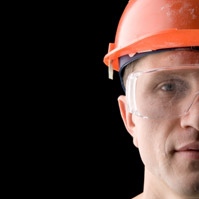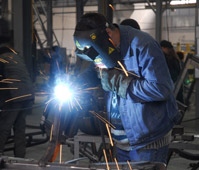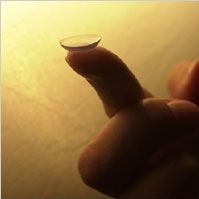Protecting Your Eyes at Work
- What are the potential eye hazards at work?
- How can I protect my eyes from injury?
- Can contact lenses be worn safely for industrial jobs?
- What should be done in an eye emergency?
 Common eye injuries occurring at work can result from chemicals or foreign objects in the eye and cuts or scrapes on the cornea. Other causes of injuries include splashes with grease and oil, burns from steam, ultraviolet or infrared radiation exposure, and flying wood or metal chips.
Common eye injuries occurring at work can result from chemicals or foreign objects in the eye and cuts or scrapes on the cornea. Other causes of injuries include splashes with grease and oil, burns from steam, ultraviolet or infrared radiation exposure, and flying wood or metal chips.In addition, health care workers, laboratory and janitorial staff, and other workers may be at risk of acquiring infectious diseases from eye exposure. Some infectious diseases can be transmitted through the mucous membranes of the eye as a result of direct exposure to blood splashes, respiratory droplets generated during coughing, or from touching the eyes with contaminated fingers or other objects.
Two major reasons workers experience eye injuries on the job are because they were:
- Not wearing eye protection, or
- Wearing the wrong kind of protection for the job.
The Occupational Safety and Health Administration (OSHA) requires the use of eye and face protection whenever there is a reasonable probability of injury that could be prevented by such equipment. Personal protective eyewear, such as goggles, face shields, safety glasses, or full face respirators must be used when an eye hazard exists. The eye protection chosen for specific work situations depends upon the type of hazard, the circumstances of exposure, other protective equipment used, and individual vision needs.
What are the potential eye hazards at work?
Potential eye hazards against which protection is needed in the workplace are:- Projectiles (dust, concrete, metal, wood and other particles)
- Chemicals (splashes and fumes)
- Radiation (especially visible light, ultraviolet radiation, heat or infrared radiation, and lasers)
- Bloodborne pathogens (hepatitis or HIV) from blood and body fluids
 The best methods of eye protection differ for each type of hazard. The protector must be matched to the potential hazard. High risk occupations for eye injuries include:
The best methods of eye protection differ for each type of hazard. The protector must be matched to the potential hazard. High risk occupations for eye injuries include:
- construction
- manufacturing
- mining
- carpentry
- auto repair
- electrical work
- plumbing
- welding
- maintenance
- If you are working in an area that has particles, flying objects, or dust, you must at least wear safety glasses with side protection (side shields)
- If you are working with chemicals, you must wear goggles
- If you are working near hazardous radiation (welding, lasers, or fiber optics) you must use special-purpose safety glasses, goggles, face shields, or helmets designed for that task
- Conducting an eye hazard assessment of the workplace
- Removing or reducing eye hazards where possible
- Providing appropriate safety eyewear and requiring employees to wear it
[back to top]
How can I protect my eyes from injury?
There are four things you can do to protect your eyes from injury:- Know the eye safety dangers at your work.
- Eliminate hazards before starting work by using machine guards, work screens or other engineering controls.
- Use proper eye protection.
- Keep your safety eyewear in good condition and have it replaced if it becomes damaged.
Selection of protective eyewear appropriate for a given task should be made based on a hazard assessment of each activity. Types of eye protection include:
- Non-prescription and prescription safety glasses — Although safety glasses may look like normal dress eyewear, they are designed to provide significantly more eye protection. They have lenses and frames that are much stronger than regular eyeglasses. Safety glasses must meet standards of the American National Standards Institute (ANSI). Look for the Z87 mark on the lens or frame.
Safety glasses provide eye protection for general working conditions where there may be dust, chips or flying particles. Additional side protection can be provided by the use of side shields and wraparound-style safety glasses.
Safety lenses are available in glass, plastic, polycarbonate and Trivex™ materials. While all four types must meet or exceed the minimum requirements for protecting your eyes, polycarbonate lenses provide the highest level of protection from impact.
 Goggles — Goggles provide impact, dust and chemical splash protection. Like safety glasses, safety goggles are highly impact resistant. In addition, they provide a secure shield around the entire eye and protect against hazards coming from any direction.
Goggles — Goggles provide impact, dust and chemical splash protection. Like safety glasses, safety goggles are highly impact resistant. In addition, they provide a secure shield around the entire eye and protect against hazards coming from any direction.
Goggles can be worn over prescription glasses and contact lenses to provide protection from flying objects and chemical splashes and in dusty environments.
- Face shields and helmets — Full face shields are used to protect workers exposed to chemicals, heat, or bloodborne pathogens. Helmets are used for welding or working with molten materials. Face shields and helmets should not be used as the sole means of protective eyewear. They need to be used in conjunction with safety glasses or goggles. Wearing safety glasses or goggles under face shields also provides protection when the shield is lifted.
- Special protection — Other types of protection, such as helmets or goggles with special filters to protect the eyes from optical radiation exposure, should be used for tasks such as welding or working with lasers.
Protective eyewear works best when you know how to use it properly. Combined with machine guards, screened or divided work stations, and other engineering controls, using the correct protective eyewear can help keep you safe from any type of eye hazard.
[back to top]
Can contact lenses be worn safely for industrial jobs?
 Contact lenses can't provide significant protection from eye hazards in the work place. However, there is no evidence that the wearing of contact lenses increases the risk of eye injury.
Contact lenses can't provide significant protection from eye hazards in the work place. However, there is no evidence that the wearing of contact lenses increases the risk of eye injury.Contact lenses may actually contribute to worker safety and productivity because they often provide improved vision in the workplace. Individuals who wear contact lenses usually obtain a wider field of vision than with eyeglasses and often have less visual distortion, especially with higher power lens prescriptions. In addition, wearing contact lenses instead of eyeglasses can provide a better, more comfortable fit of eye safety equipment, such as goggles and full face respirators.
The American Optometric Association believes (see the AOA Guidelines for the Use of Contact Lenses in Industrial Environments) that workers should be permitted to wear contact lenses in most eye hazardous environments. However, eye protection must be worn over contact lenses exactly as would be required of all workers performing the same job.
Contact lenses may be worn safely under a variety of environmental situations. In some cases, such as when hazardous chemical fumes are present, a determination of contact lens wear may need to be made on a case by case basis. Check with your employer on their safety policy regarding the wearing of contact lenses. Your optometrist can assist your employer and you in determining whether you can safely wear contact lenses in your workplace.
[back to top]
What should be done in an eye emergency?
Seek medical attention as soon as possible following an injury, particularly if you have pain in the eye, blurred vision, loss of vision or loss of field of vision. There are several simple first aid steps that can and should be taken until medical assistance is obtained.First aid for eye emergencies:
Chemicals in the eye
- Immediately flush the eye with water for at least 15 minutes. Place the eye under a faucet or shower, use a garden hose, or pour water into the eye from a clean container.
- If you are wearing contact lenses, do not wait to remove the lenses. Begin flushing the eye immediately. This may wash the lens out of the eye.
- Do not try to neutralize the chemical with other substances.
- Do not bandage the eye.
- Seek immediate medical attention after flushing.
Particles in the eye
- Do not rub the eye.
- Try to let your tears wash the speck out or irrigate the eye with an artificial tear solution.
- Try lifting the upper eyelid outward and down over the lower eyelid to remove the particle.
- If the particle does not wash out, keep the eye closed, bandage it lightly and seek medical care.
Blows to the eye
- Gently apply a cold compress without putting pressure on the eye. Crushed ice in a plastic bag can be placed gently on the injured eye to reduce pain and swelling.
- In cases of severe pain or reduced vision, seek immediate medical care.
Cuts and punctures to the eye or eyelid
- Do not wash out the eye.
- Do not attempt to remove an object that is stuck in the eye.
- Cover the eye with a rigid shield, like the bottom half of a paper cup.
- Seek immediate medical care.
